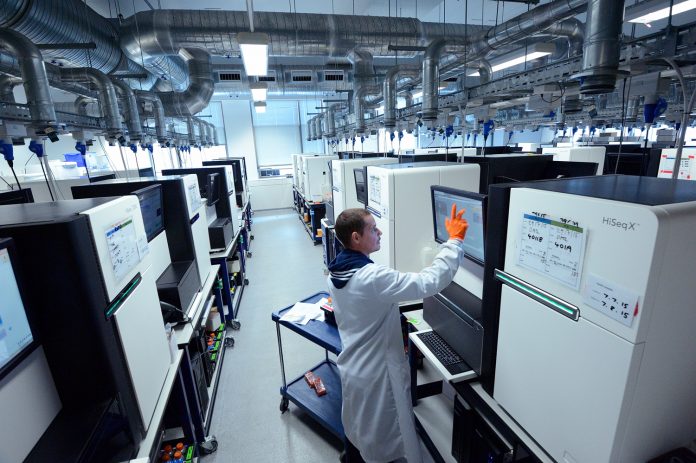Scientists who conducted a new, systematic analysis of cancer cells report the identification of 370 candidate priority drug targets across 27 cancer types, including breast, lung, and ovarian cancers.
By looking at multiple layers of functional and genomic information, researchers say they were able to create an unbiased, panoramic view of what enables cancer cells to grow and survive. They believe their work creates new opportunities for cancer therapies in represent a significant advance towards a new generation of smarter, more effective cancer treatments.
In a study “A comprehensive clinically informed map of dependencies in cancer cells and framework for target prioritization” published in Cancer Cell, researchers from the Wellcome Sanger Institute, Open Targets, and collaborators, pooled together data from 930 cancer cell lines. They then used machine learning methods to find the drug targets that show the most promise for developing new treatments, and the patients who would most benefit from such treatments. This involved assessing the occurrence of these targets in actual patient tumors and linking them to specific biological markers and genetic and molecular features found in the tumors.
![Abstract image showing how the Cancer Dependency Map is identifying specific candidate oncology targets. [Antonio Garcia / Wellcome Sanger Institute]](https://www.genengnews.com/wp-content/uploads/2024/01/Low-Res_Cancer-DepMap-abstract-image-300x300.jpg)
New precision drugs based on the exact genetic mutations that drive the cancer are needed to help the millions of patients diagnosed with some form of cancer each year, responsible for one in six deaths worldwide. However, drug development has a 90 percent failure rate, making it both costly and inefficient.
Significant challenge
With over 20,000 potential anti-cancer targets in the genome, determining which are suitable to target for specific types of cancers and patients is a significant challenge.
“Genetic screens in cancer cell lines inform gene function and drug discovery. More comprehensive screen datasets with multi-omics data are needed to enhance opportunities to functionally map genetic vulnerabilities. Here, we construct a second-generation map of cancer dependencies by annotating 930 cancer cell lines with multi-omic data and analyze relationships between molecular markers and cancer dependencies derived from CRISPR-Cas9 screens,” write the investigators.
“We identify dependency-associated gene expression markers beyond driver genes and observe many gene addiction relationships driven by gain of function rather than synthetic lethal effects. By combining clinically informed dependency-marker associations with protein-protein interaction networks, we identify 370 anti-cancer priority targets for 27 cancer types, many of which have network-based evidence of a functional link with a marker in a cancer type.
“Mapping these targets to sequenced tumor cohorts identifies tractable targets in different cancer types. This target prioritization map enhances understanding of gene dependencies and identifies candidate anti-cancer targets for drug development.”
By analyzing data available from the Cancer Dependency Map project, which involved CRISPR technology to disrupt every gene inside 930 human cancer lines one at a time, they were able to produce a comprehensive view of potential new cancer targets.
Genetic dependencies
The researchers first identified weaknesses within different cancer types (genetic dependencies), meaning which genes, proteins, or cellular processes that cancer cells rely on to survive, that could be harnessed to make new therapies. They then linked those weaknesses to clinical markers to identify patients in which those therapies would be most effective.
Finally, they explored how dependency-marker pairs fit into known networks of molecular interactions within cells, providing clues as to how cell biology is disrupted by cancer, and which targets might yield the most effective therapies.
The work provides a clearer understanding of which types of cancer can possibly be treated by existing drug discovery strategies and pinpoint areas where novel and innovative approaches are needed, noted Francesco Iorio, PhD, co-lead author of the study from the Computational Biology Research Center of Human Technopole.
“Analyzing the largest-ever cancer dependency dataset, we present the most comprehensive map yet of human cancers’ vulnerabilities—their ‘Achilles heel,’” he said. “We identify a new list of top-priority targets for potential treatments, along with clues about which patients might benefit the most, all made possible through the design and use of innovative computational and machine intelligence methodologies.”
“This work exploits the latest in genomics and computational biology to understand how we can best target cancer cells,” added Matthew Garnett. “This will help drug developers focus their efforts on the highest value targets to bring new medicines to patients more quickly.”
Two people might have the same type of cancer, but their diseases can behave differently, explained Marianne Baker, PhD, science engagement manager at Cancer Research UK. “That is why we need precision medicine,” she emphasized.


